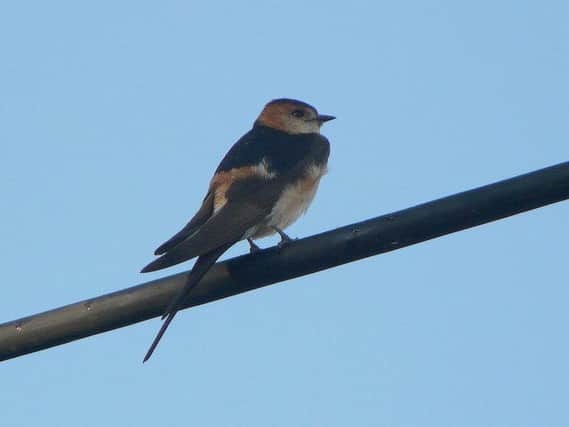Birdwatch: Red rump rides in on the winds


Another of these vagrants from the Mediterranean was seen this week, first spotted among migrating swallows at Hunmanby Gap, Filey and then two hours and 43 miles later at Spurn as it made its way back to Europe again. This follows a number of sightings in England including one which I saw which was present at Fairburn Ings over the Easter weekend.
Red-rumped swallows - picture by John Sadler - are very like our familiar summer visitor but are pinkish buff underneath instead of brilliant white and have a pinkish rump, rather like the white rump of a house martin. They also have a steadier flight and glide more than swallows.
Advertisement
Hide AdAdvertisement
Hide AdThey are a familiar sight in southern Spain and Portugal and in Greece, and have also expanded into Bulgaria and Romania.
Traditional nest sites are on cliffs and cave roofs where they first build open mud cups, close these and then build entrance tunnels. Now, about a third of the breeding population favour man-made structures, especially under bridges.
Red-rumped swallows are usually seen here in spring as they ‘overshoot’ on their way back to breeding sites from Africa. Remarkably, an immature one was present on the Norfolk coast in December and January last year, somehow finding enough insects to survive.
The first swifts are being reported, despite chilly winds this week, with some sites having their earliest ever records and raising hopes of another annual vagrant from southern Europe, an Alpine swift, appearing before long.
Advertisement
Hide AdAdvertisement
Hide AdRare harriers were a feature of the past few days with an adult male pallid harrier at Grimston, East Yorkshire on Sunday and last Friday an adult female Montagu’s harrier was seen over Hunmanby Gap, Gristhorpe and Flixton Carrs.
Another female Montagu’s harrier is back for its fourth year on the Blacktoft Sands reserve.
Cold northerlies and even snow were little encouragement for large scale spring arrivals but there were more grasshopper warblers reeling, the first singing cuckoos across the county, and a sighting of a wryneck in a garden at Thorpe Hesley, South Yorkshire.
Arctic terns were reported on passage at St Aidan’s and Pugney’s Country Park while more common terns were back at breeding sites.
Advertisement
Hide AdAdvertisement
Hide AdThere were also the first significant numbers of wheatears and ring ouzels on passage - it is worth taking a second look at any blackbird to see if it is a ring ouzel as one might turn up anywhere on pastureland, paddocks or lowland hillsides as they make their way back to upland breeding sites.
Long-tailed ducks were still present at several places while a drake green-winged teal was on the Nosterfield local nature reserve, North Yorkshire.